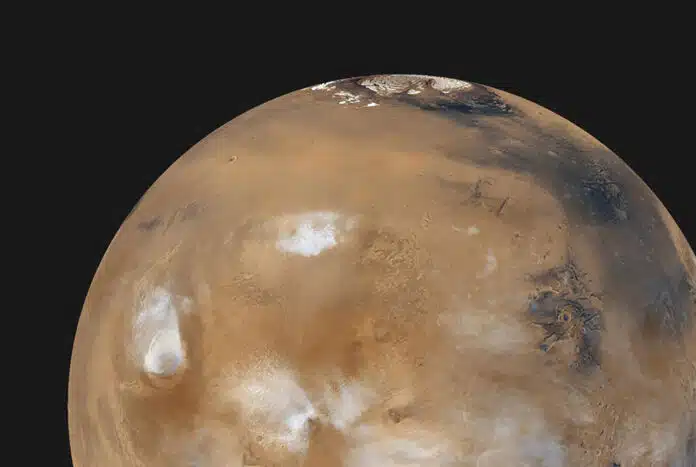
By Amit Malewar 10 Aug, 2024
Collected at: https://www.techexplorist.com/new-approach-make-mars-friendlier-life/87120/
Breaking new ground in the quest to make Mars more hospitable to life, researchers from Northwestern University, the University of Chicago, and the University of Central Florida have introduced a groundbreaking approach to potentially warm the Red Planet. Their method involves releasing engineered dust particles into the atmosphere, which could increase Mars’ temperature by over 50 degrees Fahrenheit, creating conditions suitable for microbial life.
This innovative technique is over 5,000 times more effective than previous methods, representing a significant advancement in our ability to transform the Martian environment. Lead author Samaneh Ansari, a graduate student at Northwestern, emphasized the potential of this approach to make Mars habitable.
The utilization of resources available on Mars sets this approach apart, making it more viable than previous proposals reliant on importing materials from Earth or mining scarce Martian resources.
While this strategy would require decades to execute, it is a more logistically feasible option than previously suggested plans.
“This suggests that the barrier to warming Mars to allow liquid water is not as high as previously thought,” said Edwin Kite, an associate professor of geophysical sciences at the University of Chicago and corresponding author on the study.
Transforming Mars into a habitable planet for humans is an ambitious goal that could be achieved by creating an environment suitable for microbes and food crops. This could gradually add oxygen to the atmosphere, similar to Earth’s geologic history.
There have been numerous proposals to make Mars habitable, from far-fetched ideas to scientifically plausible concepts. Overcoming challenges such as lethal UV rays and saline soil is crucial, but the most significant hurdle is the planet’s frigid surface temperature, averaging about -80 degrees Fahrenheit.
One potential strategy to warm Mars involves enhancing its natural greenhouse effect by releasing materials into the atmosphere. This approach mimics unintentional practices on Earth and could help raise the planet’s temperature to make it more hospitable for life.
The challenge lies in the extensive amount of materials needed for such a project. Previous proposals involved transporting gases from Earth to Mars or trying to extract a substantial amount of scarce resources from the Martian surface, both of which are costly and challenging endeavors. However, a research team considered the possibility of using the abundant materials already present on Mars.
Rovers like Curiosity have provided valuable insights into the composition of Mars’ dust, revealing high concentrations of iron and aluminum. Individually, these dust particles do not possess the properties needed to warm the planet; their size and composition actually contribute to cooling the surface instead of warming it. Nevertheless, the researchers pondered whether it would be feasible to modify the shape and composition of the dust particles to improve their ability to capture and retain heat more effectively.
The team devised a concept involving particles shaped like short rods, akin to commercially available glitter but tailored for a specific purpose. These specially engineered particles are intended to efficiently trap escaping heat and redirect sunlight toward the surface, ultimately enhancing Mars’ inherent greenhouse effect.
“How light interacts with sub-wavelength objects is fascinating,” Ansari said. “Importantly, engineering nanoparticles can lead to optical effects that far exceed what is conventionally expected from such small particles.”
Mohseni, a study co-author, believes that they have just scratched the surface. “We believe it is possible to design nanoparticles with higher efficiency, and even those that can dynamically change their optical properties,” he said.
“You’d still need millions of tons to warm the planet, but that’s five thousand times less than you would need with previous proposals to globally warm Mars,” said Kite. “This significantly increases the feasibility of the project.”
The calculations show that releasing particles into Mars’ atmosphere at a rate of 30 liters per second could raise the planet’s temperature by over 50 degrees Fahrenheit. This warming effect could become noticeable in a matter of months, and if the release were stopped, the warming would be reversible within a few years.
The research was conducted using the Quest high-performance computing facility at Northwestern and the University of Chicago Research Computing Center.
The scientists emphasized that there is still much to be investigated. They are uncertain about the rate at which the engineered dust would dissipate from Mars’ atmosphere. Additionally, the presence of water and clouds on Mars could lead to unexpected outcomes as the planet warms, potentially causing water to condense around the particles and return to the surface as rain.
“Climate feedbacks are really difficult to model accurately,” Kite cautioned. “To implement something like this, we would need more data from both Mars and Earth, and we’d need to proceed slowly and reversibly to ensure the effects work as intended.”
The groundbreaking method represents a major advancement in terraforming research. The study’s focus on warming Mars to temperatures suitable for microbial life and potential food crop growth is a significant step toward establishing a sustainable human presence on the planet. This research opens up new avenues for exploration, bringing us closer to realizing the long-held dream of a thriving human presence on Mars.
Journal reference:
- Samaneh Ansari, Edwin S. Kite, Ramses Ramirez, Liam J. Steele, Hooman Mohseni. Feasibility of keeping Mars warm with nanoparticles. Science Advances, 2024; DOI: 10.1126/sciadv.adn4650

Leave a Reply